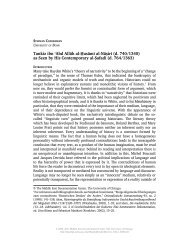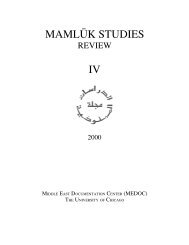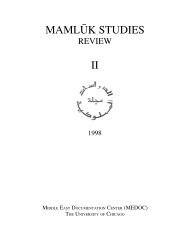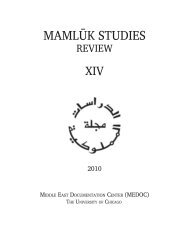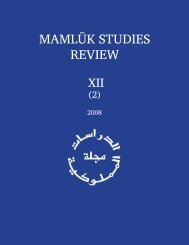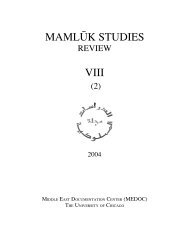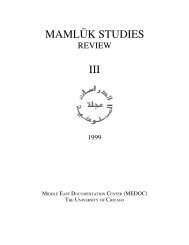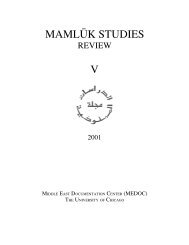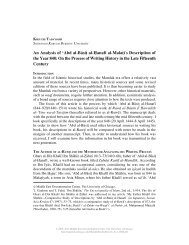Mamluk Studies Review Vol. VI (2002)
Mamluk Studies Review Vol. VI (2002)
Mamluk Studies Review Vol. VI (2002)
Create successful ePaper yourself
Turn your PDF publications into a flip-book with our unique Google optimized e-Paper software.
10 DONALD P. LITTLE, MAMLUK MADRASAHS<br />
AL-ASYU≠T¸|'S MODEL<br />
In several publications I have used al-Asyu≠t¸|'s Jawa≠hir as a basis for comparing<br />
juristic formulations of how legal documents should be prepared with the actual<br />
practice of notaries and judges in late fourteenth-century Jerusalem. 6 I have found<br />
that despite variations, documents consistently conform to juristic models. Although<br />
it would be interesting to compare and analyze any number of extant <strong>Mamluk</strong><br />
waqf|yahs with al-Asyu≠t¸|'s models, such an exercise, I am convinced, would<br />
probably confirm my earlier conclusions. Instead, focusing on al-Asyu≠t¸|'s model<br />
for endowing a madrasah I shall summarize what he thought an ideal <strong>Mamluk</strong><br />
college might be and, at the same time, draw attention to his descriptions of<br />
certain positions mentioned in such documents.<br />
Himself a Shafi‘i, al-Asyu≠t¸| states at the outset that his model could serve for<br />
any of the legal schools. 7 He devotes little space to the physical aspects of the<br />
building, satisfied with the general comment that "it is to be described and delineated<br />
in full . . . along with every place endowed for it." 8 As we shall see, al-Asyu≠t¸| also<br />
covers the possibility that the endower might choose to attach subsidiary educational<br />
facilities to the madrasah proper, namely a school for orphans and institutes for<br />
teaching the Quran and reciting hadith. He might also endow books for the madrasah.<br />
But the author's main interest lies in the personnel of the madrasah and its adjuncts:<br />
their duties, functions, and qualifications. These personnel are not discussed<br />
systematically but for our purposes can be divided into administrators, educational<br />
and devotional staff, and custodians.<br />
ADMINISTRATORS OF THE MADRASAH<br />
The endower (wa≠qif), who for charitable purposes and an afterlife in paradise<br />
provides the inalienable funds for the institution, bears ultimate responsibility for<br />
administering it, but he can be, and often is, represented by a controller (na≠z¸ir):<br />
The controller is in charge of the interests of the madrasah, its<br />
maintenance, and that of its endowments, along with obtaining its<br />
rents, revenues, and profits and disbursing them for legal expenses. 9<br />
6<br />
E.g., "Documents Related to the Estates of a Merchant and His Wife in Late Fourteenth-Century<br />
Jerusalem," Mamlu≠k <strong>Studies</strong> <strong>Review</strong> 2 (1998): 93–193; cf. idem, "The Nature of Kha≠nqa≠hs, Riba≠¸ts,<br />
and Za≠wiyas under the Mamlu≠ks," in Islamic <strong>Studies</strong> Presented to Charles J. Adams, ed. Wael B.<br />
Hallaq and Donald P. Little (Leiden, 1991), 91–106.<br />
7<br />
Al-Asyu≠t¸|, Jawa≠hir, 1:342, 343.<br />
8 Ibid., 342.<br />
9 Ibid., 343.<br />
© <strong>2002</strong>, 2012 Middle East Documentation Center, The University of Chicago.<br />
http://mamluk.uchicago.edu/<strong>Mamluk</strong><strong>Studies</strong><strong>Review</strong>_<strong>VI</strong>_<strong>2002</strong>.pdf



